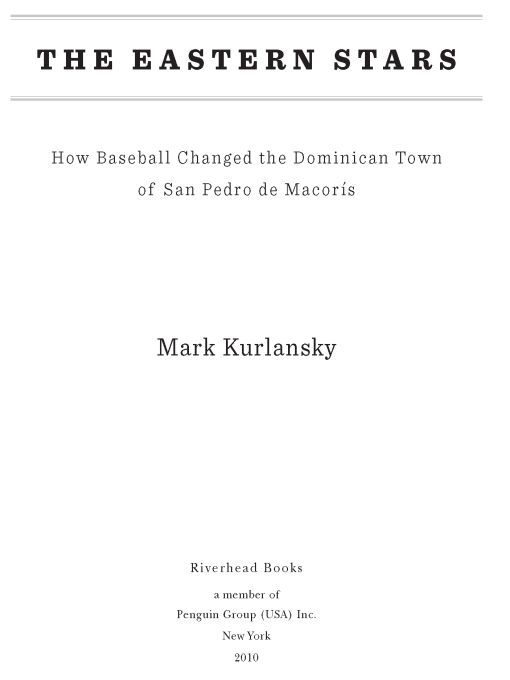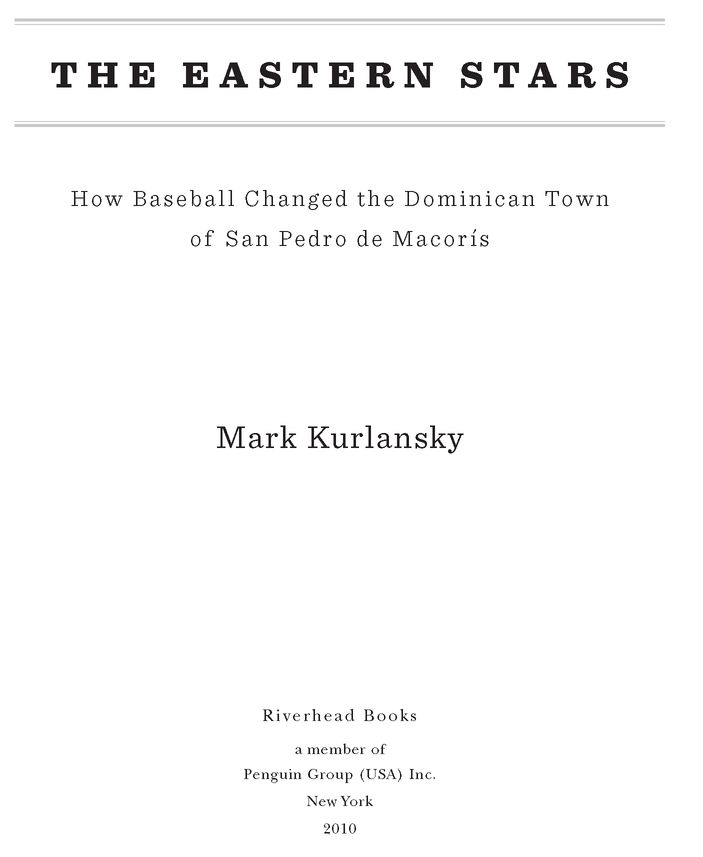The Eastern Stars
Authors: Mark Kurlansky


Table of Contents
ALSO BY MARK KURLANSKY
NONFICTION
The Food of a Younger Land: A Portrait of American Food—Before the National Highway System, Before Chain Restaurants, and Before Frozen Food, When the Nation’s Food Was Seasonal, Regional, and Traditional—from the Lost WPA Files
The Last Fish Tale: The Fate of the Atlantic and Survival in Gloucester, America’s Oldest Fishing Port and Most Original Town
The Big Oyster: History on the Half-Shell
Nonviolence: The History of a Dangerous Idea
1968: The Year That Rocked the World
Salt: A World History
The Basque History of the World
Cod: A Biography of the Fish That Changed the World
A Chosen Few: The Resurrection of European Jewry
A Continent of Islands: Searching for the Caribbean Destiny
ANTHOLOGY
Choice Cuts:
A Savory Selection of Food Writing
from Around the World and Throughout History
A Savory Selection of Food Writing
from Around the World and Throughout History
FICTION
Boogaloo on 2nd Avenue: A Novel of Pastry, Guilt, and Music
The White Man in the Tree and Other Stories
FOR CHILDREN
The Cod’s Tale
The Girl Who Swam to Euskadi
The Story of Salt
TRANSLATION
The Belly of Paris,
by Émile Zola
by Émile Zola


RIVERHEAD BOOKS
Published by the Penguin Group
Penguin Group (USA) Inc., 375 Hudson Street, New York, New York 10014, USA Penguin Group (Canada), 90 Eglinton Avenue East, Suite 700, Toronto, Ontario M4P 2Y3, Canada (a division of Pearson Penguin Canada Inc.) • Penguin Books Ltd, 80 Strand, London WC2R 0RL, England • Penguin Ireland, 25 St Stephen’s Green, Dublin 2, Ireland (a division of Penguin Books Ltd) • Penguin Group (Australia), 250 Camberwell Road, Camberwell, Victoria 3124, Australia (a division of Pearson Australia Group Pty Ltd) Penguin Books India Pvt Ltd, 11 Community Centre, Panchsheel Park, New Delhi-110 017, India • Penguin Group (NZ), 67 Apollo Drive, Rosedale, North Shore 0632, New Zealand (a division of Pearson New Zealand Ltd) Penguin Books (South Africa) (Pty) Ltd, 24 Sturdee Avenue, Rosebank, Johannesburg 2196, South Africa
Penguin Books Ltd, Registered Offices: 80 Strand, London WC2R 0RL, England
All rights reserved. No part of this book may be reproduced, scanned, or distributed in any printed or electronic form without permission. Please do not participate in or encourage piracy of copyrighted materials in violation of the author’s rights. Purchase only authorized editions. Published simultaneously in Canada
Library of Congress Cataloging-in-Publication Data
Kurlansky, Mark.
The Eastern stars : how baseball changed the Dominican town of San Pedro de Macorís / Mark Kurlansky.
p. cm.
Includes bibliographical references and index.
eISBN : 978-1-101-18686-2
1. Baseball—Dominican Republic—San Pedro de Macorís—History.
2. Baseball players—Dominican Republic—San Pedro de Macorís—History. I. Title.
GV863.29.D65K
796.35707293’82—dc22
While the author has made every effort to provide accurate telephone numbers and Internet addresses at the time of publication, neither the publisher nor the author assumes any responsibility for errors, or for changes that occur after publication. Further, the publisher does not have any control over and does not assume any responsibility for author or third-party websites or their content.
A MIS VIEJOS AMIGOS EL PUEBLO DOMINIC ANO, EN LA ESPERANZA QUE UN DÍA ENCUENTRE LA JUSTICIA Y PROSPERIDAD QUE USTED SE MERECE
AND FOR TALIA FEIGA, WHOSE GREAT HEART IS BIG AS A MOUNTAIN
(¡Tanto arrojo en la lucha irremediable
Y aún no hay quien lo sepa!
¡Tanto acero y fulgor de resistir
Y aún no hay quien lo vea!)
Y aún no hay quien lo sepa!
¡Tanto acero y fulgor de resistir
Y aún no hay quien lo vea!)
Even though there is no one who knows it!
So much steel and flashing in resistance
Even though there is no one who sees it!)
—Pedro Mir, “Si Alguien Quiere Saber Cuál Es Mi Patria” “If Someone Wants to Know Which Country Is Mine”

PROLOGUE
Gracias, Presidente
T
his is a book about what is known in America as “making it.” And like all such tales, it is also a story about not making it. In this Dominican town, San Pedro de Macorís, the difference between making it and not making it is usually baseball.
his is a book about what is known in America as “making it.” And like all such tales, it is also a story about not making it. In this Dominican town, San Pedro de Macorís, the difference between making it and not making it is usually baseball.
If you do not make it, there is sugarcane—but only for half the year. Sometime between Christmas and the Dominican national holiday on February 27, depending on how rainy the summer was, the
pendones
—white feathery shoots—appear above the rippling green cane fields of San Pedro de Macorís. In the English-speaking islands of the Caribbean, where many of the families of San Pedro’s sugar workers originated, the field is said to be “in arrow” because the
pendones
point upward. It means that the sugarcane is ripe for cutting and the cane harvest, the
zafra
, can begin.
pendones
—white feathery shoots—appear above the rippling green cane fields of San Pedro de Macorís. In the English-speaking islands of the Caribbean, where many of the families of San Pedro’s sugar workers originated, the field is said to be “in arrow” because the
pendones
point upward. It means that the sugarcane is ripe for cutting and the cane harvest, the
zafra
, can begin.
It is an exciting moment, because most people who work in sugar here have employment only during the four to six months of the
zafra
. In an election year, such as 2008, at the beginning of the harvest a sign goes up at the Porvenir sugar mill, which is controlled by the ruling party. It says,
“Gracias, Presidente, por una nueva zafra,”
Thank you, President, for a new cane harvest, as though he, Leonel Fernández, the New York-educated caudillo—running again as he had in 2004 and in 1996, which was the last time Dominicans believed he offered anything new, his face on posters everywhere with the smile of an encyclopedia salesman—had personally caused the sugarcane to grow.
zafra
. In an election year, such as 2008, at the beginning of the harvest a sign goes up at the Porvenir sugar mill, which is controlled by the ruling party. It says,
“Gracias, Presidente, por una nueva zafra,”
Thank you, President, for a new cane harvest, as though he, Leonel Fernández, the New York-educated caudillo—running again as he had in 2004 and in 1996, which was the last time Dominicans believed he offered anything new, his face on posters everywhere with the smile of an encyclopedia salesman—had personally caused the sugarcane to grow.
Some of the San Pedro mills—Santa Fe, Angelina, Puerto Rico, and Las Pajas—no longer operate. Four working mills remain, though not at full capacity: Quisqueya, Consuelo, Cristóbal Colón, and Porvenir. When the
zafra
is on, red glows can be seen from San Pedro along the northern horizon where the mill fires burn all night, cooking down cane juice. Porvenir, which in Spanish means “future,” was originally on the edge of the city like the others, but the town grew around it and now trucks full of grape-red sticks of cane must drive through the traffic-clogged center of town to deliver to the mill.
zafra
is on, red glows can be seen from San Pedro along the northern horizon where the mill fires burn all night, cooking down cane juice. Porvenir, which in Spanish means “future,” was originally on the edge of the city like the others, but the town grew around it and now trucks full of grape-red sticks of cane must drive through the traffic-clogged center of town to deliver to the mill.
Street kids, the ones who survive by shining shoes or washing the windshields of the cars that stop at traffic lights, run behind the trucks and pull off canes to suck. Sometimes they hold a stick of cane in a batter’s stance. On the street, San Pedro boys regularly coil into a batter’s stance anyway. Having a stick in hand, some can’t resist taking a practice swing with a small rock—a dangerous habit in the crowded parts of town. But if they were to make a mistake and hit a rich man’s shiny large SUV, chances are the wealthy driver hiding behind the smoked glass would be a baseball player who not that many years before had himself been whacking around stones with a stalk of sugarcane.
The road out of town that leads to the other mills begins at the green, white, and ocher Estadio Tetelo Vargas, home of the Estrellas Orientales, the Eastern Stars. San Pedro’s long-suffering and always promising baseball team, founded in 1910, is older than many of the major-league clubs in America. With a center-field wall at 385 feet, Tetelo Vargas is a major-league-size field, though with fewer seats, more like a Triple A stadium. Behind the outfield wall, the drooping fronds of tall palms can be seen, and in the distance, sticking up behind right field, the smokestack of Porvenir.
The road alongside the stadium goes straight north—a rutted pockmarked remnant of the once paved two-lane route that has hosted too many trucks, which now dangerously zigzag around potholes. The road leads through the rural zone that is still San Pedro to whole villages that have grown up around the mills after which they were named: Angelina, Consuelo, Santa Fe . . . Soon—still in San Pedro—the road seems like a causeway over a vast vegetable sea with lapping silver and green waves of sugarcane. Some already-cleared fields look as if they had gotten bad haircuts. Leggy white birds called
galsas
graze there until sunset, when they nest in the trees at the fields’ edges.
galsas
graze there until sunset, when they nest in the trees at the fields’ edges.
Other books
Wild Boy by Nancy Springer
Trial by Fire by Jeff Probst
The Wedding Dress by Marian Wells
Marrow by Elizabeth Lesser
His Ward by Lena Matthews
Circo de los Malditos by Laurell K. Hamilton
Piranha by Clive Cussler
Tempted by a Lady’s Smile by Christi Caldwell
Eagle (Jacob Hull) by Debenham, Kindal
The Small Miracle by Paul Gallico
